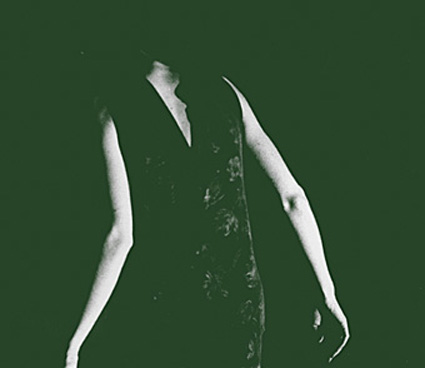Surprising even the body that makes it
Philipa Rothfield on improvised dance works in Melbourne

Ros Warby
Sitting in the darkness, audience and performers alike wait for Ros Warby’s Enso to begin. We are forced to listen—to the rustles and coughs of others, whilst we open ourselves to the moment. Sometimes it is hard to identify an improvised work but listening is often one of its telltale signs. Enso moves between 3 performers, dancer (Ros Warby), cellist (Helen Mountfort) and singer (Jeannie Van de Velde). The flow of material throughout the piece is punctuated with spaces where each performer listens, waiting for each other to begin.
We are told that the structure of the work is set but that its content is open. There is a sense that the performers know who will begin a section. Eyes flicker towards Mountfort’s cello, ears strain towards Van de Velde’s voice, bodies lean to where Warby is waiting to move. But, and this is another of improvisation’s telltale signs, there is an episodic character to the flow of the piece. At one point, Warby’s movements are driven to the wall by Van de Valde’s vocal crescendo. Then a waiting for the next interaction to occur. A little later, Warby develops a most beautiful, intricate spinning motion across the room, then stops. More listening. A fan of Warby’s dancing, I want more from her. I don’t want her to wait for the others, to do nothing while allowing their contribution. But I have to accept the equity of the situation, its play between leading, listening, following, playing solo, making duets, forming trios.
There is scintillation to Warby’s movement, an exquisite attention to detail—the curlicue of her fingers, the twisted line of an arm—which speak of the moment. The attention permeating Warby’s body fills the most minute of spaces in a glorious detail; a dimly lit arm, curling and shaping itself, the length of a back spiralling into the turn of a head. One of Warby’s distinctive qualities is her ability to vary her speed with little apparent effort. Her work is textured by a subtle variety of velocities. A contemplation of fingers, wrist, and arm becomes a fast moving checkerboard of movement without notice.
Although set choreography can admit of any amount of depth and detail, there is a perceptual awareness which resonates in some improvisational work. One senses that the performer is utterly engaged in the moment, discovering and perceiving the work as it occurs. This distinguishes improvisation from set choreography, for the performer is making the work as it is being performed. Here, the performer, like audience, apprehends the unfolding of the work within the temporality of the performance itself. That makes for a certain degree of excitement.
Seasoned performers, Peter Trotman and Andrew Morrish, exploit that excitement for their own and other’s amusement. Their latest work, The Charlatan’s Web, is full of very funny moments where one performer invents a brazen complication which the other partner must incorporate. We the audience are invited to gloat over the sudden landscape which improvisation is able to thrust upon its subjects. The Charlatan’s Web was developed over 4 performances into an epic tale of character and intrigue. A man without qualities is banished from a religious cloister for the mortal sin of knowledge. He sails away to avoid execution, ultimately jumping ship in order to spin a web of chicanery and deceit. Andrew Morrish plays the hapless novice-cum-artful trickster, and Peter Trotman the feverish priest, who devours his books with a carnal lust.
The work begins with a duet, where Trotman and Morrish move simply from the back of the stage to the front. This enables them to establish a play of timing and rapport. Once established, the duo moves apart. A good deal of the tale is told by one performer moving and the other providing narrative, whether on stage or off. The work has a gem-like quality, of candle-lit cameos such as Trotman’s intense portrayal of the priest huddled over his books, sucking out their contents; the main character is himself a man of many faces; and the narrative just a series of fragments.
This is largely a play between word and movement. Neither performer exhibits a dancerly technique. Their panache comes from their energy and timing. They are utterly committed to their performance and to each other, such that the work as a whole and the contribution of each is seamless. I think the longevity of the Trotman-Morrish partnership—16 years—enables this duo to comfortably risk the narrative flow of their work for the greater good of the piece. Trotman and Morrish have just returned from the 1997 New York Improvisational Festival, where Deborah Jowitt of the Village Voice described them as “two extremely wily, full throttle performers whose nutty dancing and subtle timing elevate verbal wit into inspired madness” (December 1997).
Enso and The Charlatan’s Web are ultimately distinguished by the technical skills that each performer brings to the improvisational moment. Despite the indeterminacy of improvisation, the history of people’s work inevitably speaks though their performance. Though the work itself may be fresh, the skills that make it possible are not gained so easily. It seems like a contradiction in terms to prepare for improvisation, but it takes some dexterity to produce work which surprises even the body making it.
–
Enso, A Choreography between Movement and Sound, Ros Warby, Helen Mountfort, and Jeannie Van de Velde, Danceworks, Melbourne, March 27 – April 5; The Charlatan’s Web, Peter Trotman and Andrew Morrish, Dancehouse, Melbourne, March 29 – April 5
Philipa Rothfield is a Melbourne academic (Philosophy, La Trobe University) and sometime performer. Her next work, Logic, will be shown at Mixed Metaphor, Dancehouse, July 2 – 5
RealTime issue #25 June-July 1998 pg. 15






